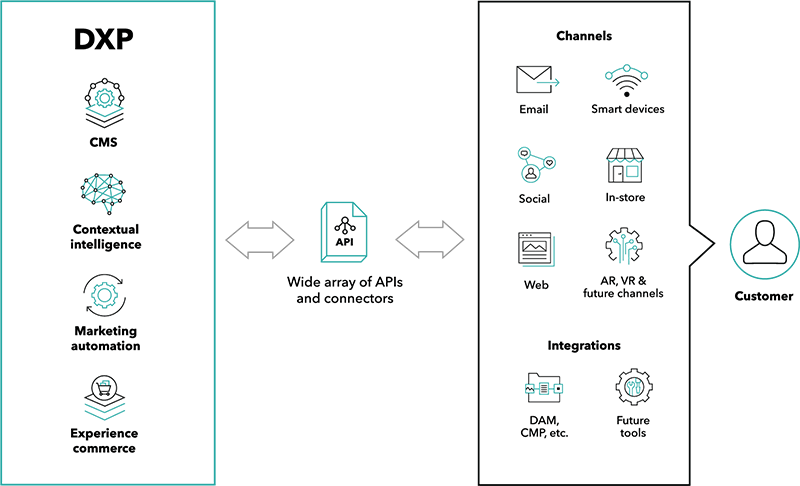At Y, we believe that the best Digital Experience Platforms (DXPs) are built to preserve the integrity of the data in an API-first solution agnostic manner.
Digital Experience Platforms have the potential to change how businesses. In part I of this series, we discussed the basics of what a Digital Experience Platform (DXP) is and how they can help businesses achieve their strategic goals. In part II, we’re examining how we do DXPs here at Y. We have a different take on DXPs compared to other creators – we think that the data is the most important thing and thus work towards an API-first, solution agnostic DXP. That is, starting with the data, we build the DXP in a way that allows solutions to be swapped out as needed in an ever-changing product landscape.
Why API-First?
It’s a good question without a quick answer. There are a few reasons for it.
- Multi-channel control
The amount of marketing channels a typical company handles has expanded in recent years and will continue to do so in the future. Businesses must not only respond to consumers quickly but also must keep those responses consistent in terms of content, feel, and logic. APIs hand out raw information in a pre-defined way, and every channel can present the raw information in their own structured way, which is where API-first architecture shines. This means you only have to write the FAQ document once, and it will work on the web, mobile app, customer portals, voice assistants, chatbots, and any other digital channel you want. Once you’ve modified the FAQ document, it’ll be updated everywhere. APIs can provide whole elements as a service, not just basic content and data, such as create pricing logic once and share it with apps, third-party retailers, social media, and everywhere else you want consistent data. - Connecting Business Services
Any B2C business needs multiple business services. You’ll need a marketing platform to get customers in the door, a commerce platform to manage inventory and purchases, a support environment to work with current customers, and the flexibility to pick and choose other point solutions that meet your specific requirements. The DXP is at the heart of all of this, using APIs to integrate and orchestrate data in order to evaluate and deliver the best possible experience to customers every time they step through the (digital) door.

If a department already has a favorite tool, they can link it to the DXP via APIs and easily add and remove tools, making experimentation and change far easier.
- Flexible Architecture
The DXP’s underlying framework must be versatile in order for the above connections to work.
To accomplish this, we use a microservice architecture. What exactly does this imply? This ensures that back-end logic and front-end presentation are decoupled, allowing developers and marketers to make improvements to both easily and independently. It also ensures that platform improvements can be done gradually, with changes to one section causing no disruption to the others. Businesses may also use the DXP in the most productive manner for them because of its efficiency.
They can use “content-as-a-service” (Headless) to store and serve content in a centralized API, or “experience-as-a-service” to serve whole elements to front-end applications. They can also use it for full site delivery, where marketers edit and publish content and presentation directly to the website.
It’s All About the Data
We believe that if you start with the data, and build from there, you’ll be in the best shape and will have a DXP that is both future proof and agile. So when we approach building a DXP for our clients, we begin with the tenet that at the base level, data should not be transformed by anything. We can transform it to enable certain integrations, but we always have access to the base data. This is in contrast to the more common ‘out of the box’ configurations of DXPs that are built to fit the solutions and programs already in use by the client. While this approach works in the short term, it can cause problems down the road when those solutions are either outdated, don’t work for the way the company needs them to work, aren’t able to be scaled, or just aren’t right anymore. When a DXP is built for the solutions at hand, rather than in a solution agnostic way, it is usually less expensive to build, but more expensive to maintain as any change to any of the connected solutions requires a substantial amount of time and effort to implement. With our data-first, solution agnostic approach, there is more time and expertise needed at the outset, but changes are easier to make afterwards. Given that DXPs are long term investments in the connectivity of your business, it is important to look at the whole lifecycle cost.
How to Get Started with a DXP
Digital transformation is needed to fully implement DXP. It’s more than simply making a digital experience, It’s about providing the best digital experience possible.
Having a functional website or app is just the beginning. If your goal is true digital transformation for better customer engagement, you need a CMS that can scale easily, can be deployed on the cloud, and has a wide array of APIs for fluid integrations. As your organization, teams, and capabilities mature, you can increase functionality, eventually getting to DXP.
You’ll have to learn to integrate your digital channels with your business operations and learn how to apply business rules to customer interactions. Any legacy service needs to be addressed, as well as any source of customer data needs to be linked. And you’ll need a partner who has experience helping companies transition from CMS to DXP, which is where Y comes in. We can help you create a DXP that will be agile and able to grow as your business does.
Ready to learn more about how a Digital Experience Platform could transform your business? Contact us today.


